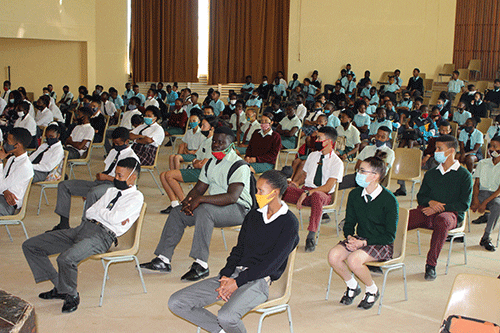Albertina Nakale
Hopes could be dashed for Namibia’s first batch of advanced subsidiary learners, as they will be sitting for their final exams without having completed the set syllabus for their Namibian Senior Secondary Certificate Advanced Subsidiary (NSSCAS) level.
The education ministry had procured textbooks to the tune of N$30 million for learners reporting on 16 February. However, most of the syllabus could not be covered due to continuous disruptions of teaching and learning brought by Covid-19.
The implementation of NSSCAS in Namibia since the 2021 academic year is part of the third basic education change that started in 2012, following resolutions taken at the 2011 education conference, which includes phasing out HIGSE in 2010. This means grade 11 is the first exit point from basic education.
Education ministry executive director Sanet Steenkamp explained how Covid-19 has affected the curriculum implementation, especially the advanced subsidiary (AS) level, which is being implemented in the midst of a deadly global pandemic.
She stated that on the curriculum side, the implementation as such was not affected and went on as planned.
“We are all excited and working hard in anticipation of the first examination on NSSCAS at the end of the year, 2021. However, due to the Covid-19 pandemic, there was less face-to-face teaching and learning time, which made it difficult to complete syllabuses. At the AS level, it is even felt more severe, as it is only a one-year course,” Steenkamp remarked.
Pre-primary to Grade 9 syllabuses were rationalised to help teachers cope.
However, Steenkamp differentiated that for senior secondary (National Senior Secondary Certificate Ordinary Level-NSSCO and NSSCAS), full syllabus coverage is expected, as the examinations are internationally accredited.
As an alternative, she stressed, the ministry this year introduced a winter holiday and the national examination dates were adapted to start later to allow teachers and learners to catch up on the time lost during school closures.
“Many schools made alternative arrangements to cover the syllabuses and prepare learners for examination.”
In terms of the minimum requirement for learners to enter university from grade 11 are not determined by the ministry but by the institutions of higher learning.
“Due to the fact that each institution of higher learning has its own entry requirements for their respective qualifications, it is not in the mandate of the ministry to determine the entry requirements at institutions of higher learning,” Steenkamp echoed.
The curriculum stipulates that grade 11 learners can progress to the advanced subsidiary level if they meet the set admission requirements of that level.
This means that learners who will obtain a C or better grade in three or more subjects should proceed to AS level in the formal school system. The old and new NSSCO, as well as NSSCAS certificates or qualifications, are accepted at any institution of higher learning, depending on the course the student wants to study.
In essence, the new reviewed curriculum has been fully implemented as follow:
Junior Primary (Pre-primary to Grade 3)
Senior Primary (Grades 4-7)
Grade 8
Grade 9
Grade 10 first (year of the new NSSC ordinary level)
Grade 11 (first national examinations of the new NSSC ordinary level)
Grade 12 (advanced subsidiary level)
A full school career still takes 12 years, starting with the pre-primary grade, followed by grade 1 to grade 11, and ending with the NSSCO examination. The grade 12 year makes provision of the NSSCAS level, which serves as a bridging course to university.
The first education reform was done at independence in 1990 until 2003.
In 2004, a second education reform was held until 2008, which was preceded by the 2011 national education conference. The third education reform was done in 2014.
The old curriculum under lower primary school comprised grade-4, while the reviewed school system starts from pre-primary to grade 3 at junior primary.
Upper primary under the old curriculum was from grades 5-7 – unlike the new system, where the senior primary is from grades 4-7.
Also, the old system had junior secondary from grade 8-10, while the revised curriculum has junior secondary, stretching from grade 8-9.
The senior secondary school phase under the old system had grades 11 and 12, compared to the current system, where the senior secondary is of two years duration for grade 10 to 11, with grade 12 (AS) being optional.
– anakale@nepc.com.na
Caption (Education curriculum):


